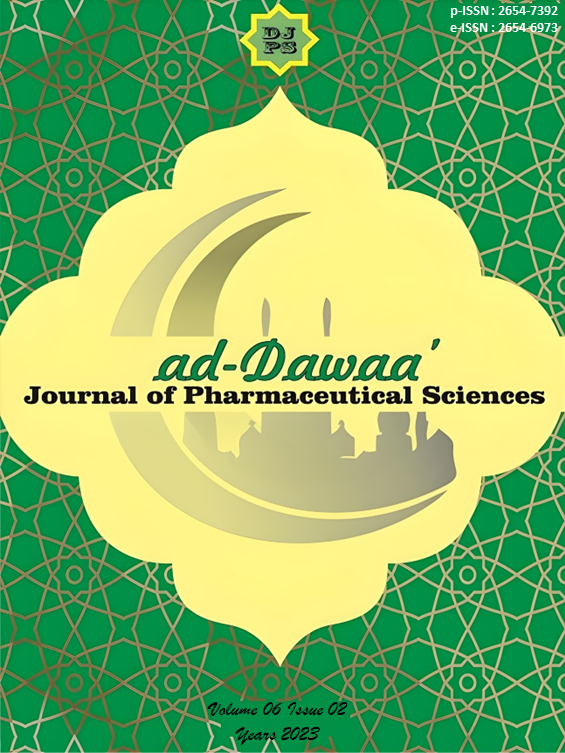Burns Wound-Healing Activity in Male White Rats of Matoa Stem Bark (Pometia pinnata) Ethanolic Extract
Abstract
Introduction: Burns are a global public health problem. The activity of herbal products in stimulating burn wound healing is supported by many animal studies and few clinical trials. The people of Papua New Guinea use the chewed bark of the matoa tree to heal burns. Matoa's stem bark contains flavonoids, terpenoids and tannins that promote wound healing. These compounds have antimicrobial, antioxidant and wound healing properties. They increase blood clotting, fight infection and accelerate wound healing. Aims: The aim of this research was to determine whether ethanol extract of Matoa stem bark has anti-burn activity against male white rats of the Sprague Dawley strain. Method: In this study, a method was used to measure the area of burn wound in 5 treatment groups for 14 days. Group I were treated with the MEBO ointment (the positive control group); Group II with vaseline flavum (the negative control); Group III was given Matoa bark extract ointment at a concentration of 10%; group IV at a concentration of 20%, while group V at a concentration of 30%. Result: Qualitative analysis of chemical compounds shows that the ethanolic extract of Matoa stem bark contains flavonoids, triterpenoid tannins, and saponins. Ethanol extract of matoa bark 20% and 30% had burn wound healing activity in male Sprague-Dawley white rats. Activity was significantly different from negative control and not significantly different from positive control. Conclusion: A 20% and 30% ethanolic extract of the stem bark Matoa is considered a topical agent for use in treating burns wound.
Downloads
References
Chaudhary, N. A., Munawar, M. D., Khan, M. T., Rehan, K., Sadiq, A., Tameez-ud-din, A., Bhatti, H. W., & Rizvi, Z. A. (2019). Epidemiology, Bacteriological Profile, and Antibiotic Sensitivity Pattern of Burn Wounds in the Burn Unit of a Tertiary Care Hospital. Cureus, 11(6), 6–12. https://doi.org/10.7759/cureus.4794
Herman, A., & Herman, A. P. (2020). Herbal products for treatment of burn wounds. Journal of Burn Care and Research, 41(3), 457–465. https://doi.org/10.1093/JBCR/IRAA010
Jeschke, M. G., van Baar, M. E., Choudhry, M. A., Chung, K. K., Gibran, N. S., & Logsetty, S. (2020). Burn injury. Nature Reviews Disease Primers, 6(1). https://doi.org/10.1038/s41572-020-0145-5
Lanham, jason, Nelson, N., & Hendren, B. (2020). Outpatient Burn Care : Prevention and Treatment. Am Fam Physician, 101(8), 463–470.
Lumintang, L., Adnyana, M. S., Riasa, I. N. P., Asmarajaya, A. A. G. N., Hamid, A. R., & Sanjaya, H. (2021). A systematic review: Topical sucralfate for burn wound. Open Access Macedonian Journal of Medical Sciences, 9, 516–522. https://doi.org/10.3889/oamjms.2021.6253
Lumintang, R. F., Wuisan, J., & Wowor, P. M. (2015). UJI EFEK ANALGESIK EKSTRAK KULIT BATANG POHON MATOA (Pometia pinnata) PADA MENCIT (Mus musculus). Jurnal E-Biomedik, 3(2), 3–8. https://doi.org/10.35790/ebm.3.2.2015.8620
Nabilah, A., & Sutoyo, S. (2019). Uji Aktivitas Antioksidan Ekstrak Metanol Kulit Batang Tumbuhan Matoa (Pometia pinnata). UNESA Journal of Chemistry, 8(3), 117–118. https://jurnalmahasiswa.unesa.ac.id/index.php/unesa-journal-of-chemistry/article/view/30911
Prihanti, G. S., Katjasungkana, R. M. K., Novitasari, B. R., Amalia, S. R., Nurfajriana, A., Agustini, S. M., Cakrawati, H., & Andari, D. (2020). Antidiabetic potential of matoa bark extract (pometia pinnata) in alloxan-induced diabetic male rat strain wistar (rattus norvegicus). Systematic Reviews in Pharmacy, 11(8), 88–97. https://doi.org/10.31838/srp.2020.8.13
Rahmawati, R., Tahir, M., & Amir, A. H. W. (2021). KANDUNGAN SENYAWA KIMIA DAN AKTIVITAS FARMAKOLOGI TANAMAN MATOA (Pometia Pinnata J.R. Forster & J.G. Forster). As-Syifaa Jurnal Farmasi, 13(2), 108–115. https://doi.org/10.56711/jifa.v13i2.778
Selvakumar, P. M., Rajkumar S, R. J., & MSA, M. N. (2018). Phytochemicals as a potential source for anti-microbial, anti-oxidant and wound healing - a review. MOJ Bioorganic & Organic Chemistry, 2(2). https://doi.org/10.15406/mojboc.2018.02.0058
Skowrońska, W., & Bazylko, A. (2023). The Potential of Medicinal Plants and Natural Products in the Treatment of Burns and Sunburn—A Review. Pharmaceutics, 15(2). https://doi.org/10.3390/pharmaceutics15020633
Tambingon, V. G. M., Yamlean, P., & Siampa, J. (2023). Antibacterial Potential Test of Cream Preparation of Ethanol Extract of Matoa Stem Bark (Pometia pinnata) against Staphylococcus aureus. Pharmacon, 12, 70–76. https://ejournal.unsrat.ac.id/v3/index.php/pharmacon/article/view/42190%0Ahttps://ejournal.unsrat.ac.id/v3/index.php/pharmacon/article/download/42190/41929
Thomson, L. A. J., & Thaman, R. R. (2006). Pometia pinnata (tava). Journal Species Profiles for Pacific Island Agroforestry, April, 1–8. www.traditionaltree.org
Wardhana, A., & Winarno, G. A. (2020). Epidemiology And Mortality Of Burn Injury In Ciptomangunkusumo Hospital, Jakarta: A 5 Year Retrospective Study. Jurnal Plastik Rekonstruksi, 6(1), 234–242. https://doi.org/10.14228/jpr.v6i1.270
WHO. (2018). Burn. https://www.who.int/en/news-room/fact-sheets/detail/burns
Zeiniyah, S., Simaremare, E. S., & Rusnaeni. (2019). Antibacterial Activity Test of the Liquid Soap of Matoa ’ s Stem Bark (Pometia pinnata) against Staphylococcus aureus and Escherichia coli. 1(2), 40–46. https://www.matjournals.in/index.php/RTPScR/article/view/3756
Zhou, S., Xiao, S., Wang, X., Wang, X., & Han, L. (2023). Risk Factors and Pathogens of Wound Infection in Burn Inpatients from East China. Antibiotics, 12(9), 1432. https://doi.org/10.3390/antibiotics12091432
Copyright (c) 2023 Ad-Dawaa' Journal of Pharmaceutical Sciences

This work is licensed under a Creative Commons Attribution-ShareAlike 4.0 International License.
Once an article was published in the journal, the author(s) are:
- granted to the journal right licensed under Creative Commons License Attribution that allows others to share the work with an acknowledgement of the work's authorship.
- permitted to publish their work online in third parties as it can lead to wider dissemination of the work.
- continue to be the copyright owner and allow the journal to publish the article with the CC BY-SA license
- receiving a DOI (Digital Object Identifier) of the work.


1.png)